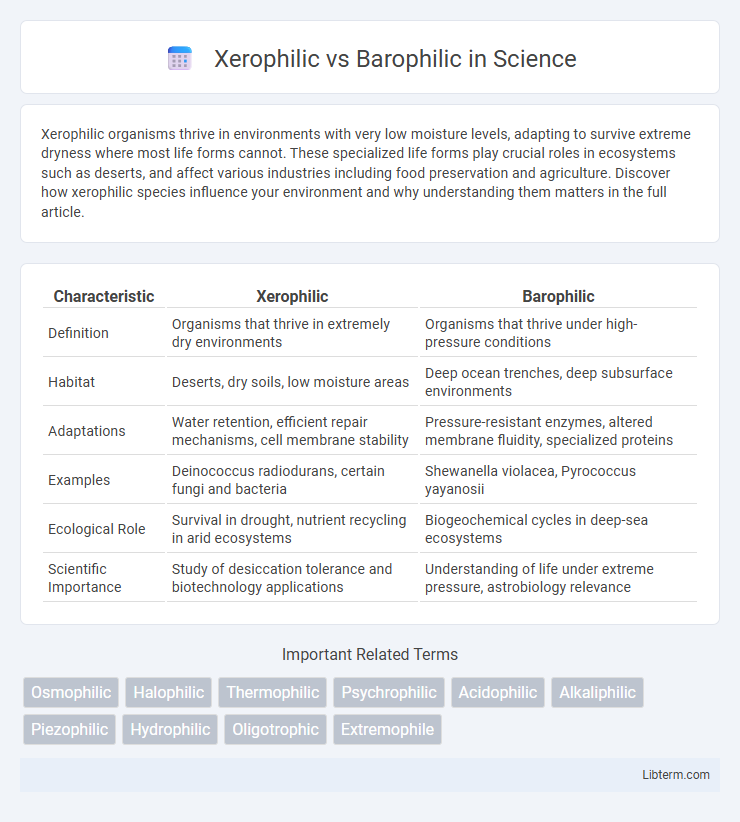Xerophilic organisms thrive in environments with very low moisture levels, adapting to survive extreme dryness where most life forms cannot. These specialized life forms play crucial roles in ecosystems such as deserts, and affect various industries including food preservation and agriculture. Discover how xerophilic species influence your environment and why understanding them matters in the full article.
Table of Comparison
| Characteristic | Xerophilic | Barophilic |
|---|---|---|
| Definition | Organisms that thrive in extremely dry environments | Organisms that thrive under high-pressure conditions |
| Habitat | Deserts, dry soils, low moisture areas | Deep ocean trenches, deep subsurface environments |
| Adaptations | Water retention, efficient repair mechanisms, cell membrane stability | Pressure-resistant enzymes, altered membrane fluidity, specialized proteins |
| Examples | Deinococcus radiodurans, certain fungi and bacteria | Shewanella violacea, Pyrococcus yayanosii |
| Ecological Role | Survival in drought, nutrient recycling in arid ecosystems | Biogeochemical cycles in deep-sea ecosystems |
| Scientific Importance | Study of desiccation tolerance and biotechnology applications | Understanding of life under extreme pressure, astrobiology relevance |
Understanding Xerophilic and Barophilic Organisms
Xerophilic organisms thrive in environments with low water availability, adapting their cellular structures to prevent desiccation and maintain metabolic functions under extreme dryness. Barophilic organisms, also known as piezophiles, are specialized to live under high-pressure conditions, such as deep-sea trenches, optimizing protein stability and membrane fluidity for survival. Understanding the unique adaptations of xerophiles and barophiles provides insight into extremophile biodiversity and their potential applications in biotechnology and astrobiology.
Environmental Adaptations: Dryness vs. Pressure
Xerophilic organisms thrive in environments with extreme dryness, adapting to low water availability by developing mechanisms like efficient water retention and metabolic adjustments to prevent desiccation. Barophilic organisms adapt to high-pressure habitats, such as deep-sea environments, by evolving specialized cell membranes and pressure-resistant enzymes that maintain cellular function under intense hydrostatic pressure. These environmental adaptations illustrate the distinct strategies life employs to survive either arid conditions or elevated pressure, demonstrating the diversity of extremophile niches.
Key Differences Between Xerophilic and Barophilic Microbes
Xerophilic microbes thrive in extremely dry environments by tolerating low water activity, while barophilic microbes adapt to high-pressure conditions commonly found in deep-sea habitats. Xerophiles utilize specialized mechanisms to retain water and protect cellular structures from desiccation, whereas barophiles possess cellular adaptations to maintain membrane fluidity and enzyme function under intense pressure. These fundamental ecological and physiological differences define their survival strategies and environmental niches.
Mechanisms of Survival in Extreme Conditions
Xerophilic organisms survive extreme desiccation by producing protective molecules such as trehalose and late embryogenesis abundant (LEA) proteins that stabilize cellular structures and prevent protein denaturation. Barophilic microorganisms adapt to high-pressure environments through modifications in membrane lipid composition, increasing unsaturated fatty acids to maintain membrane fluidity, and by expressing pressure-resistant enzymes with altered tertiary structures. Both strategies involve molecular adaptations that preserve cellular integrity and functionality under environmental extremes.
Notable Examples of Xerophiles and Barophiles
Notable xerophiles include fungi such as *Aspergillus penicillioides* and bacteria like *Deinococcus radiodurans*, which can thrive in extremely dry environments. Prominent barophiles, or piezophiles, include deep-sea bacteria like *Photobacterium profundum* and *Shewanella benthica*, which are adapted to survive under high hydrostatic pressure in oceanic trenches. These microorganisms exhibit specialized adaptations allowing them to endure and grow under their respective stress conditions of desiccation or pressure.
Ecological Roles and Habitat Diversity
Xerophilic organisms thrive in environments with low water availability, such as deserts and dry soils, playing crucial roles in nutrient cycling and organic matter decomposition under arid conditions. Barophilic organisms inhabit high-pressure environments like deep-sea trenches, contributing to biogeochemical processes including carbon cycling and supporting unique deep-ocean ecosystems. The ecological roles of these extremophiles reflect their adaptations to distinct habitats, influencing ecosystem functions in xeric terrestrial and high-pressure marine environments.
Industrial and Biotechnological Applications
Xerophilic microorganisms thrive in low-moisture environments, making them valuable in industrial processes like food preservation and dry fermentation techniques where moisture control is critical. Barophilic bacteria, adapted to high-pressure conditions, are exploited in biotechnology for the production of pressure-stable enzymes useful in deep-sea bioprocessing and pharmaceutical synthesis. Harnessing xerophilic and barophilic traits enhances efficiency in industrial fermentation, biocatalysis, and the development of resilient bio-products under extreme environmental conditions.
Evolutionary Insights into Extremophile Adaptations
Xerophilic organisms have evolved to thrive in extremely dry environments by developing cellular mechanisms that minimize water loss and stabilize proteins under dehydration stress. Barophilic extremophiles, adapted to high-pressure habitats such as deep-sea trenches, exhibit membrane fluidity adjustments and specialized enzymes that maintain function under intense hydrostatic pressure. Comparative genomic studies reveal convergent evolutionary strategies in stress response pathways, highlighting molecular adaptations that enable survival in these distinct but challenging conditions.
Challenges in Studying Xerophilic and Barophilic Species
Studying xerophilic species presents challenges due to their adaptation to extremely dry, low-water environments, which complicates laboratory replication of natural conditions and affects their metabolic activity. Barophilic species require high-pressure environments found in deep-sea habitats, making it difficult to simulate their pressure-dependent physiology accurately outside specialized pressurized chambers. Maintaining the specific environmental parameters for both xerophilic and barophilic organisms is essential for understanding their ecological roles and biochemical adaptations, yet current experimental setups often struggle with sustaining these extreme conditions consistently.
Future Research Directions in Extremophile Biology
Future research in extremophile biology will focus on deciphering the molecular mechanisms that enable xerophilic organisms to survive in extremely dry environments and barophilic organisms to thrive under high-pressure conditions, such as deep-sea habitats. Advances in genomics and proteomics will facilitate the identification of unique genes and proteins responsible for desiccation tolerance and pressure adaptation. Integrating bioinformatics with experimental approaches promises to uncover novel biotechnological applications, including stress-resistant enzymes and biomolecules for industrial and medical use.
Xerophilic Infographic

 libterm.com
libterm.com